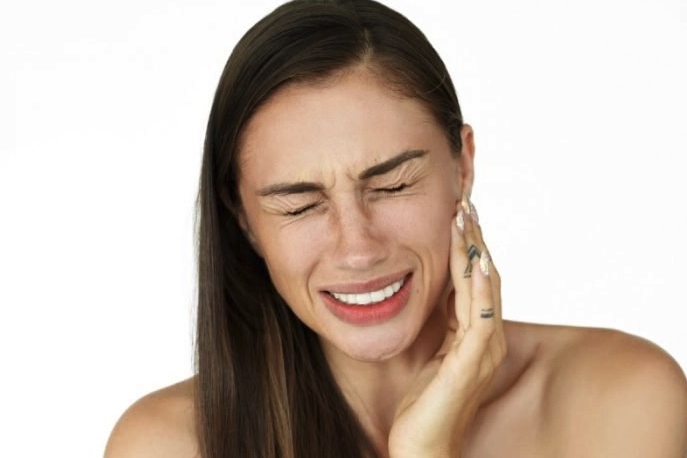Facial pain is one of the most frequent complaints by patients who go to ENT clinics for help. At the same time, true facial pain is observed in a third of the patients who complain, while secondary facial pain caused by pathology of the ENT organs, ophthalmological problems, and dental disorders make up the vast majority of cases. One of the main nosological forms is temporomandibular joint (TMJ) dysfunction syndrome – one of the most difficult and controversial diagnoses in modern medicine. Symptoms of temporomandibular joint disease are observed in up to 40% of people, but not everyone seeks medical help.
What is temporomandibular joint (TMJ) dysfunction?
The head of the lower jaw, the articular surface of the temporal bone, the articular disc located between them, the articular capsule, as well as the ligamentous apparatus, and the chewing muscles take part in the formation of our joint. The joints are located anterior to the ear canal and work synergistically.
Temporomandibular joint dysfunction means that one of the components of our joint is not functioning properly. This joint is one of the most complex joints in the human body. It is responsible for the movement of the lower jaw backward, forward, and from side to side. Any pathological condition that prevents this complex system of ligaments, muscles, disc, and bones from working properly leads to its dysfunction.
What are the symptoms of temporomandibular joint disorders?
TMJ pain dysfunction or TMJ pain dysfunction syndrome has many synonyms:
Painful dysfunction of the joint is characterized by the following manifestations:
- headache (frontal-temporoparietal localization), ear pain, as well as pain and pressing sensations behind the eyes;
- “Crunch” or “click” when opening or closing the mouth;
- pain when yawning and wide-open mouth;
- spasm of the chewing muscles;
- displacement of the centerline of the jaw;
- malocclusion.
The variety of clinical manifestations of dysfunction of the temporomandibular joint is determined by the polyetiology (many reasons) of the pathological processes developing in it, which complicates the diagnosis and treatment.
What Causes TMJ Disorders?
In general, TMJ disorders are a multifactorial process. These factors can be divided into two types: problems with the masticatory muscles and problems with the joint itself. Muscle problems are the most common type, especially for young people.
Muscle problems can be caused by:
- Muscle hyperactivity. This can happen if you clench your jaw frequently, especially when you sleep, which is quite common.
- Cicatricial changes in the masseter muscles
- Hypersensitivity to pain. This may be due to stress, or some other process that affects pain sensitivity
Joint problems can be caused by:
- Degenerative-dystrophic changes in the joint
- Joint inflammation (arthritis)
- TMJ injury
What is the treatment for temporomandibular disorders?
Most of the problems in the jaw joint can be resolved using simple procedures such as pain relievers and muscle relaxants, physiotherapy and exercise therapy, and advice on how to relieve the joint. The procedures are aimed at relaxation and anti-stress therapy. Mouthguards and bite pads can also be used.
In case of more severe disorders in the joint or the ineffectiveness of conservative methods, they resort to injections of botulinum toxin into the chewing muscles with their hyperactivity and intra-articular administration of steroids.
Arthroscopy is a minimally invasive surgical treatment using endoscopic equipment.
A very small percentage of patients may be eligible for surgery in the form of open joint surgery. As a rule, these are gross deformities of the joint in the form of ankylosis.
Help for TMJ disorders
Diagnosis of disorders in the work of the temporomandibular joint requires an integrated approach, otherwise, it is difficult to establish a diagnosis and prescribe an effective treatment for TMJ diseases.
In order to effectively treat the problem with a particular patient’s TMJ, our specialists at Potomac ENT use a set of measures, which, depending on the specific situation, include:
- bite correction
- medication management
- muscle injection
- surgical intervention
- coordination with dental professionals when appropriate
You can find out more about what type of treatment is required to eliminate problems with the temporomandibular joint by contacting us to schedule an appointment.
References
Nancy Choi, M.D. Annette McDermott, March 7, 2019. What Temporomandibular Joint (TMJ)?
Retrieved from: https://www.healthline.com/health/tmj-exercises#:~:text=TMJ%20disorders%20occur%20when%20something,pain%20while%20chewing
Michael Friedman, DDS, October 10, 2019. Temporomandibular Joint Disorders (TMD, TMJ)
Retrieved from: https://www.webmd.com/oral-health/guide/temporomandibular-disorders-tmd
Retrieved from: https://mountainent.com/blog/what-is-tmj
Retrieved from: https://www.mayoclinic.org/diseases-conditions/tmj/diagnosis-treatment/drc-20350945

